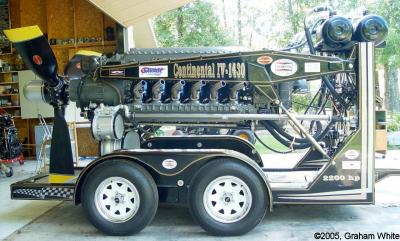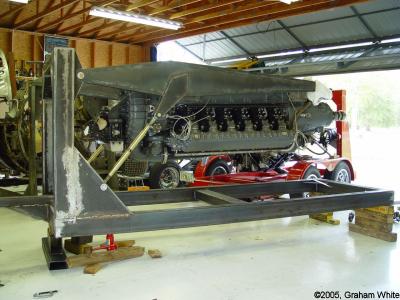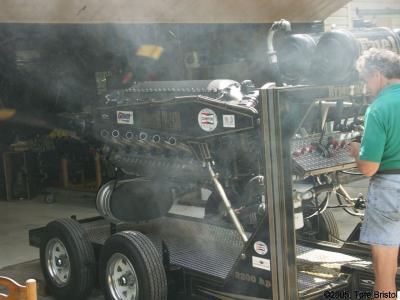
Rarest of the Rare
A Continental IV-1430
by Graham White
 |
| - More Pictures - |
Occasionally you get lucky when collecting aircraft engines. Such was the case when I obtained the ultra rare Continental IV-1430. This engine represented one of the last gasps of the ill fated "Hyper Program." Amazingly, despite the expenditure of huge sums of money and taking up the best resources the country could offer during the 1930s, this program has been all but forgotten. Due to a number of occurrences such as the Great Depression, mismanagement and poor timing nothing ever came of it. Notwithstanding its lack of success some fascinating engines were developed to comply with the Hyper requirements. These requirements included one horsepower per pound of weight, one horsepower per cubic inch, buried installation capability and high temperature operation.
A number of years ago during a trip to East Hartford I took time out to visit the New England Air Museum. As with most museums the best stuff is stashed away in the "back lot" where excess and unwanted inventory is stored. Sitting forlornly in one of the storage sheds sat a sight that I found unbelievable; surely this couldn’t be an IV-1430? Sure was. Furthermore it appeared to be in good condition if one looked beyond the years of accumulated dust and crud. Icing on the cake was the fact it sat in its original shipping crate. And even this was a work of art, not one wood screw or nail, it was all held together with aircraft grade fasteners. It also had the hallmarks of being built by a master carpenter. Little wonder that NOS (new old stock) parts left over from WWII are still in brand new condition thanks to the extraordinary lengths taken for long term storage and packaging. Back to the IV-1430, after admiring it for some time I continued poking around the back lot. However, I didn’t forget the Continental; I thought, gosh, what a great addition to my collection this would make. Once I latch onto an idea I’m like a pit bull, no dissuading me otherwise as to the efficacy or practicality of such an idea.
After returning home I put a call into my good friend Jack Connors who also happens to be the engine curator of the NEAM. I enquired as to the disposition of the Continental; he said he’d look into it. Jack suggested that I write a letter to Mike Speciale, the Museum’s Director. Long story short, Mike agreed to part with the Continental at a very fair price. Living in North Carolina at the time made for a long trip to pick it up but it fit in the bed of my truck nicely. After getting it home, it was obvious that it would be some time before I could get around to working on it. Due to other obligations such as holding down a high stress day job, working on the R-2800 book and other commitments meant that I couldn’t strike a lick on it. Even so, it was hard to resist the temptation to just ogle at this prize. Removing inspection plates revealed what appeared to be a zero time engine — lots of cosmolene and beautifully polished steel parts. As an aside, I am still astounded at the quality and workmanship inside WWII aircraft engines, regardless of manufacturer.
Another piece of good luck occurred when my good friend Al Marcucci, owner of "Savage Magneto Services" in Hayward California told me about a friend of his who represented Champion Spark plugs. Before I knew it a brand new set of 24 Champion plugs arrived in the mail. This made a major contribution to the budgetary concerns of the project. A year after retiring from the "day job" my wife and I moved (returned) to Florida. We purchased a house on an airport community with a 2,000 square foot hanger — enough room for my toys — finally. Now I could get going on the Continental. Obtaining a complete set of manuals is a must do with an engine project, however, I figured my chances would be slim to none on obtaining these key documents. As they say; noting ventured nothing gained. I put a call into the National Air & Space Museum, lo and behold they had ‘em all; parts, overhaul, fits and clearances and service. If you can put up with their bureaucracy and less than friendly attitude towards customers they are a great source of hard to find manuals. Furthermore, their copies are from originals rather than 10th generation copies you typically get from the commercial manual companies.
First order of business was to design a display trailer. After retiring I no longer had access to CATIA or any other CAD system. So I bit the bullet and purchased my own. Good grief, the price on this software is now dirt cheap. I paid $49 for a system that would have cost over $100K 20 years ago — such is progress, this is the kind I like. One aspect of the project had been gnawing at me — what to do with the shipping crate. Any thought of pitching it out would have broken my heart, that’s part of my pack rat genetic makeup. Then a friend came up with a great idea; make a planter out of it. So now it’s adorned with pansies, petunias and other assorted flowers. Looks great. After locating a metal fabrication shop I gave them detail drawings of the parts needed for the trailer, engine mount etc. They used a computer controlled plasma cutter that did a perfect job of making the parts with a surprising degree of accuracy. Now it was simply a case of welding up the parts. But when you only have a wimpy little 125 amp MIG welder things take time. Still, my time is cheap these days.
 |
| - More Pictures - |
Being such a rare engine, no mounts have survived, which left me the job of coming up with one. There are two basic schools of thought for inline engine mounts; tubular or box section. I chose to go with a box section mount with a support strut. The original plan was to design my own strut with turnbuckle capability and Heim joints on both ends. This was another occasion when I got lucky. Walking through a tractor supply store I ran into the very thing I needed; a tractor top link from a 3-point hitch. It was massive, strong and furthermore looked the part; it appeared as if it belonged on an aircraft, agricultural engineering at its finest. This is why it pays to keep your eyes peeled for items that could be used on a project totally unrelated to their designed purpose. Along those lines 10 gallon air tanks serve as fuel and oil tanks. A trip to Miami to visit another good friend, Carlos Arana, owner of Florida Airline Services secured more parts; pre-oil pump, actually a feathering pump for a Hamilton Standard prop, DC-7 oil cooler used as a radiator, throttle quadrant, Convair 440 oil cooler used as, yes, an oil cooler and a generator.
At one time 50 spline props were a-dime-a-dozen. Not any more. Thanks to the folks who are making house ornaments out of props and other aviation memorabilia they are now getting in short supply. Exacerbating the situation is the FAA. Even though it is not illegal to store non airworthy parts, it gets the attention of the FAA, the kind of attention you get from the IRS when they say they are visiting to help. Consequently, many shops are pitching out many parts that could be put to good use for non airworthy projects. Anyway, I ended up paying a lot more than I expected for a ubiquitous 23E50 prop from a DC-3. This prop had been used as a test club so was missing the pitch change mechanism and was locked into one setting. A trip to Avon Park in central Florida with my neighbor, Jack Wells a retired American Airlines captain, to pick up the prop took the best part of a day. One idiosyncrasy of the IV-1430 that had concerned me from day one was the fact it turned backwards, i.e., left hand rotation. Hen’s teeth are as common as dirt compared to the availability of 50 spline left hand rotation props. I settled on a 23E50 because I figured I could index it around to produce thrust in the correct direction. What I didn’t figure on was the fact the blade root gear teeth do not go all the way around. Even so I managed to catch the last tooth on the blade to give me about 100 degrees, i.e., 10 degrees past full feather.
It has been my experience that projects never go smoothly — at least for me. A number of minor and not so minor catastrophes struck, all of which were thankfully resolved. One of the more significant was the time I smashed in the magneto. I had been working on it on the pad outside the hanger with the engine hanging on the cherry picker. After it was time to call it quits for the day I rolled it back into the hanger. Problem is when you have about 2,500 pounds on the roll a lot of inertia is built up, especially when you ride over a bump. Murphy kicked in big time, after it went over the bump and built up a good head of steam, it was impossible to stop. Crash..!! The whole rig smashed into the towing hitch of another trailer. The impossible to replace magneto cover was destroyed. I put a desperate call into Al Marcucci. Not surprisingly Al did not have a replacement but he said send it over, which I did. About two weeks later UPS delivered a perfect cover. Al had worked his miracles again, the repair job made it look better than new. Electrical systems included starter energize, starter engage, primer pump, pre oil pump, left & right mags, etc. I had three aircraft 24VDC relays but I needed a fourth. A visit to the local NAPA store located the very part — a truck starter solenoid, designed for 24VDC.
High-end paint is now outrageously priced; try on $600 for a gallon of Imron for instance. After biting the bullet I walked out of the paint store $1000 poorer and this was just for the trailer and mount. In retrospect I should have gone the powder coating route. This is now the hot set-up for painting parts; extremely durable, chip resistant, very nice finish and costs less than material alone for a paint job. You know how I’m going to finish my next display trailer. However, I did powder coat the prop, tanks, trailer fenders plus a number of small brackets and detail items. The only caveat in going the powder coat route is the high temperature required for curing, 400°F. This restriction eliminates anything soldered, Bondo’d, plastic, rubber etc. Axles, fenders and tow hitch were purchased from a trailer supply store. I’d heard good things about the rubber torsion suspension system now popular on trailers so I thought let’s give it a shot. Turned out to be a good decision; compact (you don’t see any springs), smooth (natural hysteresus of rubber helps) and light. Some J.C. Whitney graphics added some pizzazz to the trailer and a local graphics company made the rest of the "decoration" based on CAD drawings I supplied.
The aforementioned DC-7 oil cooler turned out to be somewhat of a fiasco. First off I cleaned out every tube — all 12,000 of them..!! That little chore took almost a week. Filling it with solvent showed up "some" leaks. After plugging about 12 tubes I ran out of purpose made plugs so resorted to using taper pins. Plugging about another 50 tubes the leaks were not abating so I gave up on it after spending about 2 weeks trying to resurrect this derelict from Miami’s Corrosion Corner. Kind of like the little Dutch boy who tried to plug a leak in the dike with his finger — except he had more luck, probably because he had smaller leaks to deal with. A few futile calls determined that DC-7 oil coolers are another once common item that have all but disappeared. Plan "B" was to use a DC-6 oil cooler as a radiator. This turned out to be easier to obtain and I ended up with a nice freshly overhauled cooler. For a coolant header tank a 5-gallon air tank did the job. Hooking up the cooler, cylinder banks and header tank resulted in a fairly complex system. Stainless tubing from a dairy, automobile exhaust parts and plumbers rubber couplings got everything routed to where it was supposed to go. Similarly with the oil system the same types of parts were press ganged into service that they were never intended for. The control panel consisted of a DC-3 throttle quadrant, shielded/guarded switches and WWII gages (the ones that glow in the dark).
 |
| - More Pictures - |
Now for the acid test; would this engine fire up after a 63-year hibernation? After pre-oiling and purging all the air out of the lubrication system it was time for a try. To make things easier I squirted a good dose of ether into the carburetor. Energizing the starter gave the characteristic slow build up to a crescendo that only an inertia starter can emit. Engaging the starter gave me the surprise of my life, it started almost immediately..!! However, it just burned off the ether then died. At least I knew I had a runner. Further encouragement was assured by the fact it immediately showed 115 psi oil pressure. After a few more attempts at starting, success ensued. It sounded very crisp and healthy albeit with the front two cylinders blowing some oil smoke. However, it would not accelerate beyond about 1, 500 rpm; a sure sign the carburetor was shot. After a few more runs, the engine refused to start after burning off the prime.
Time to pull the carburetor and send it off to the worlds leading expert on Bendix injection carburetors, Pete Law. After disassembly, not surprisingly the diaphragms were totally shot, hard and brittle. The challenge now was to find a flow sheet for this odd ball carburetor. Although it was basically a ubiquitous PD-12, it was an odd ball P2 variant that featured updraft induction — among many other "different" idiosyncrasies. All the carburetor shops in the US were called; none had the essential flow sheet. I ended up calling South Bend, Indiana where the carb was originally manufactured. Bendix had long divested itself of the carburetor business and it was taken over by Honeywell. I eventually found a couple of guys at Honeywell who actually cared about what their company built many years ago. Even so, the essential flow sheet remained elusive. Again, every carburetor shop in the US was called and asked to turn over every rock — still no success. Pete was extremely concerned, he just did not want to "guess" at the flow characteristics.
Then another stroke of good luck. Dan Whitney, who was also on the case, remembered during a bike ride that he had run into a box of XP-67 material during his visit with Kim McCutcheon and other AEHS members to the National Archives. He gave the folder numbers and box number where the material could be located. It would probably have required a trip to Washington DC to retrieve copies. But more luck..!! Kim remembered that he had copied some XP-49 material. Sure enough that all important flow sheet information was included in the reports Kim had copied. Phew, that was a close one. However, it highlights the importance of the work Kim McCutcheon is doing in unraveling the aviation material held by the National Archives. It is a veritable gold mine of information, not only for historians but from a practical perspective as well, amply illustrated by the carburetor information that came to light.
Another problem that surfaced was an oil leak that put the Exxon Valdese to shame. Most (all?) dry sump engines have one oil inlet (pressure) and one oil outlet (scavenge). Not the 1430. Unusually, this engine has two oil outlets, unbeknown to me. Upon start up scavenge oil puked out of the "extra" oil outlet. This required a revamp of the oil system but was fairly straight forward to fix. Expecting all kinds of air locks in the cooling system, it was a pleasant surprise to find none. Looking inside the header tank with the engine running revealed a good facsimile of Niagara Falls from the two cylinder bank discharges. Anticipating the usual coolant leaks the engine was initially run with raw water, however, that proved to be unnecessary; no leaks.
Future plans are to share this vital part of aviation history with like minded aviation enthusiasts at shows, conventions etc. Continental delivered a total of 23 IV-1430s. Of this number it appears that only three have survived and mine is the only runner, in fact probably the only one capable of running. This puts it in the world’s rarest running engine league.